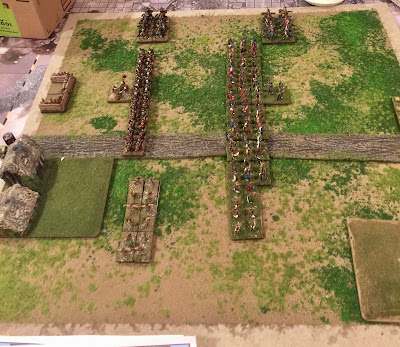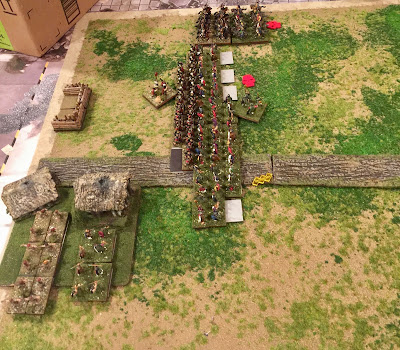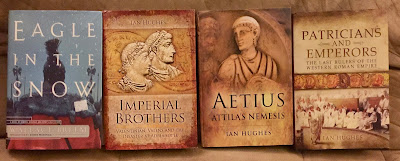The Roman list:
The Gallic OB was adjusted for this playtest and instead of three BGs of 8s, 2 BGs of 12 were chosen.
The Gallic Chieftain wins the initiative for this game and opts to play in Hilly terrain. The Roman Pilus Prior takes the compulsory gentle hill and an impassable. The Gallic Chieftain takes a village, a forrest and a broken. On placement, the impassable, the broken and the forrest are all discarded with rolls of 6s. The village lands just left of the center of the Roman baseline. The hill lands on the right flank of the Gallic baseline. The Gallic Chieftain also places a road across the table.
From atop the hill on the Gallic side, the Romans deployed the slingers inside the village with one legionnaire BG across the road and the second to its right. The Roman cavalry is on its flank.
The Gallic Ruteni deploy with the cavalry on their left followed by the two 12 packs of warriors (4 files of 3 ranks each) and the javelinmen on the hill.
For the Roman 1st turn, the legionnaires move 3" straight ahead. The Roman slingers move 4" straight ahead and shift 1 base to their right. The Roman cavalry wheel right 1", move forward 3" and wheel 1" left to come more in front of their Gallic counterparts. Again there is no shooting and the Roman 1st turn ends.
For the Gallic 2nd turn, the Gallic Chieftain opts to maneuver but fails to realize that the Roman slingers are within 4" of his left warband. The left Gallic warband fails it's CMT not to charge and charges. The Roman slingers evade back into the village. The warband ends up charging 4" forward. In the maneuver phase, the right warband moves in line with the left warband. The javelinmen move 5" forward. The Gallic cavalry do a double wheel to end up square in front of the Roman cavalry. In the shooting phase, the Gallic javelinmen score no hits on the slingers. The Gallic 2nd turn thus ends.
To start the Roman 2nd turn, the Pilus Prior launches the legions and the cavalry forward into the Gallic hordes. The Gallic Chieftain pitches in to support the right warband and the Pilus Prior joins his own left legion. In the impact, the left legion gives out 4 hits and takes 4 in return. The Pilus Prior survives but the legion loses a base on the death roll. The right legion scores 1 hit on the Gallic right warband (from the Gallic perspective) and 1 on the left warband. In return, it takes 2 from the right warband and 5 from the left warband. The right legion loses a base to hits but passes its cohesion test. The Gallic Chieftain survives the impact and neither warband suffers from death rolls. The Roman cavalry score 3 hits on the Gallic cavalry who give 2 in return. The Gallic cavalry survive their death roll and pass cohesion. After conforming for the upcoming melee, the only maneuver the Romans have left is to move the slingers another 1" into the village and turn around. This movement ensures there is no shooting this phase. In melee the Roman cavalry scores 2 hits to none. The Gallic cavalry, however, pass both their death roll and cohesion test. The left Roman legion scores 3 hits to 3 on the right warband. The right Roman legion scores 1 hit on the right Gallic warband and 2 on the left warband. In return, it takes 3 from the left warband but none from the right. Both generals survive the melee. Neither legion loses a base on their death rolls. The right warband loses a base to the death roll and disrupts on its cohesion. There is nothing to be done in joint action at this time so the Roman 2nd turn ends.
For the Gallic 3rd turn, there are no charges, so the javelinmen move to within 2" of the slingers. In the shooting phase, the javelinmen score no hits. The slingers can only muster 1.5 dice which is not enough to effect the javelinmen so the shooting phase ends. In melee, the Gallic cavalry score 1 hit to 3 and disrupt on their cohesion test after passing their death roll. The right warband manages 1 hit versus the left legion and none versus the right legion. The left warband also fails to score a hit. The left legion scores 2 hits on the right warband while the right legion scores 2 on the left warband. The Gallic Chieftain survives and the right warband survives its death roll. It does not, however, survive its cohesion test and fragments. The left warband surfers a base loss from hits and disrupts. There is nothing that either side can do in joint action so the turn ends.
For the Roman 3rd, the slingers move back 2" into the village and turn around. After the move, there is no shooting to be had so the phase ends. In melee, the Roman cavalry score 2 hits to 1 on the Gauls. The Gallic cavalry survive the death roll but fragment. The left legion scores 4 hits on the right warband and takes 2 in return. The right legion fails to hit the right warband but scores 2 hits on the left warband. The left warband fails to hit the legion in return. Both generals survive this round of melee. The right warband loses a base to the death roll but passes its cohesion. The left warband passes its death roll but fragments on its cohesion test. Neither side has anything they can do in joint action so the Roman 3rd turn ends.
The Gallic 4th turn begins with no charges. The javelinmen move into the village. Neither side has enough dice for effective shooting so the phase ends. In melee, the Gallic cavalry manages 1 hit to 3. While they survive the death roll, they break on cohesion. The Gauls have lost at this point with 4 attrition points lost but the phase must be finished. The right warband scores 3 hits on the left legion while taking 4 in return. The right warband also scores 1 hit on the right legion who suffers 2 from the left warband. The right legion matches the warband hits on it to draw the combat. Both generals survive the melee. Both legions survive their death rolls. The left warband survives its death roll while the right warband suffers a 1 base loss. The right warband breaks on its cohesion test. The left warband somehow survives its post battle cohesion test for seeing friends break but the game is over nevertheless.
Probably missed some quality rerolls in the melee for this game which would really have only made the game end much quicker. As it was, the game was over from set-up to finish in under an hour (approx. 55 minutes).
Hopefully, we have cowed the hostile Gauls in our path and we should arrive in Vienne within the week. The Pilus Prior has done nothing but sing his praises since the victory. It will be nice to get back with the army...
Lines from the journals of Hastatus Posterior Lucius Lutatius Calvus


































